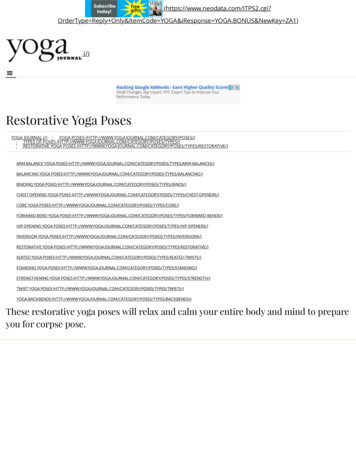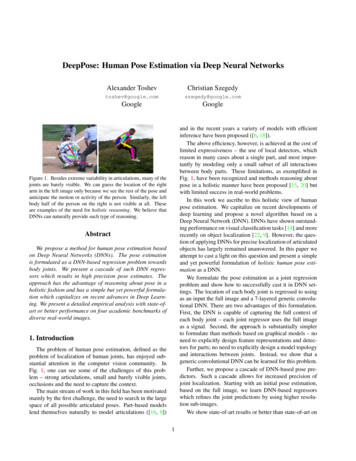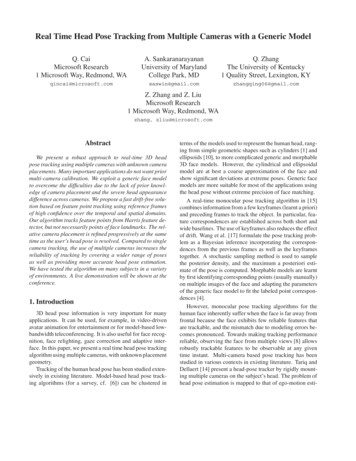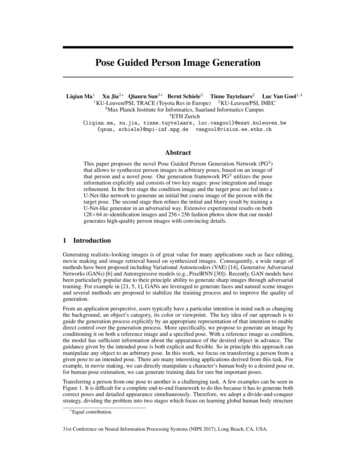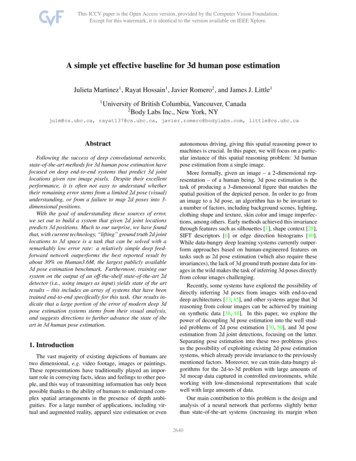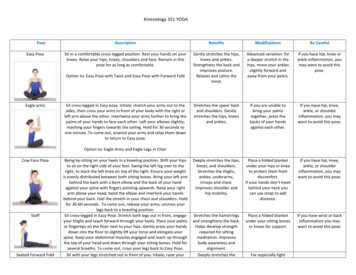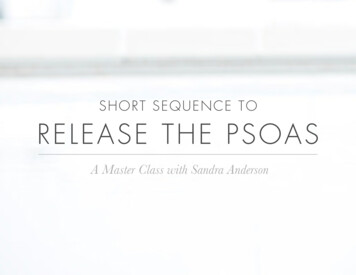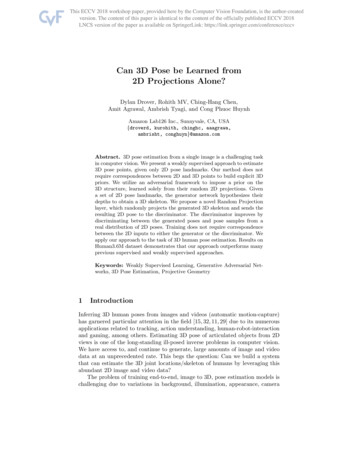
Transcription
Can 3D Pose be Learned from2D Projections Alone?Dylan Drover, Rohith MV, Ching-Hang Chen,Amit Agrawal, Ambrish Tyagi, and Cong Phuoc HuynhAmazon Lab126 Inc., Sunnyvale, CA, USA{droverd, kurohith, chinghc, aaagrawa,ambrisht, conghuyn}@amazon.comAbstract. 3D pose estimation from a single image is a challenging taskin computer vision. We present a weakly supervised approach to estimate3D pose points, given only 2D pose landmarks. Our method does notrequire correspondences between 2D and 3D points to build explicit 3Dpriors. We utilize an adversarial framework to impose a prior on the3D structure, learned solely from their random 2D projections. Givena set of 2D pose landmarks, the generator network hypothesizes theirdepths to obtain a 3D skeleton. We propose a novel Random Projectionlayer, which randomly projects the generated 3D skeleton and sends theresulting 2D pose to the discriminator. The discriminator improves bydiscriminating between the generated poses and pose samples from areal distribution of 2D poses. Training does not require correspondencebetween the 2D inputs to either the generator or the discriminator. Weapply our approach to the task of 3D human pose estimation. Results onHuman3.6M dataset demonstrates that our approach outperforms manyprevious supervised and weakly supervised approaches.Keywords: Weakly Supervised Learning, Generative Adversarial Networks, 3D Pose Estimation, Projective Geometry1IntroductionInferring 3D human poses from images and videos (automatic motion-capture)has garnered particular attention in the field [15, 32, 11, 29] due to its numerousapplications related to tracking, action understanding, human-robot-interactionand gaming, among others. Estimating 3D pose of articulated objects from 2Dviews is one of the long-standing ill-posed inverse problems in computer vision.We have access to, and continue to generate, large amounts of image and videodata at an unprecedented rate. This begs the question: Can we build a systemthat can estimate the 3D joint locations/skeleton of humans by leveraging thisabundant 2D image and video data?The problem of training end-to-end, image to 3D, pose estimation models ischallenging due to variations in background, illumination, appearance, camera
D. Drover, R. MV, C. Chen, A. Agrawal, A. Tyagi, C. P. HuynhProjections matchreal distributionof 2D posesHypothesis12Good 3D skeleton estimate(re-projects to x)Projections seen fromrandom directionsHypothesisProjections do notmatch real distributionof 2D poses22D Input pose(x)Bad 3D skeleton estimate(re-projects to x)Projections seen fromrandom directionFig. 1. Key intuition behind our approach: A generator can hypothesize multiple 3Dskeletons for a given input 2D pose. However, only plausible 3D skeletons will projectto realistic looking 2D poses after random projections. The discriminator evaluatesthe “realness” of the projected 2D poses and provides appropriate feedback to thegenerator to learn to produce realistic 3D skeletonscharacteristics, etc. Recent approaches [26, 30] have decomposed the 3D poseestimation problem into (i) estimating 2D landmark locations (corresponding toskeleton joints) and (ii) estimating 3D pose from them (lifting 2D points to 3D).Following such a scheme, suitable 2D pose estimators can be chosen based onthe application domain [42, 31, 6, 13] to estimate 2D poses, which can then befed to a common 2D-3D lifting algorithm for recovering 3D pose.A single 2D observation of landmarks admits infinite 3D skeletons as solution;not all these are physically plausible. The restriction of solution space to realisticposes is typically achieved by regularizing the 3D structure using priors such assymmetry, ratio of length of various skeleton elements, and kinematic constraints.These priors are often learned from ground truth 3D data, which is limited dueto the complexity of capture systems. We believe that leveraging unsupervisedalgorithms such as generative adversarial networks for 3D pose estimation willhelp address the limitations of capturing such 3D data. Our work addresses thefundamental problem of lifting 2D image coordinates to 3D space without theuse of any additional cues such as video [47, 40], multi-view cameras [2, 14], ordepth images [35, 46, 38].We present a weakly supervised learning algorithm to estimate 3D humanskeleton from 2D pose landmarks. Unlike previous approaches we do not learnpriors explicitly through 3D data or utilize explicit 2D-3D correspondence. Oursystem can generate 3D skeletons by only observing 2D poses. Our paper makesthe following contributions: We present and demonstrate that a latent 3D pose distribution can belearned solely by observing 2D poses, without requiring any regression from3D data. We propose a novel Random Projection layer and utilize it along with adversarial training to enforce a prior on 3D structure from 2D projections.
Can 3D Pose be Learned from 2D Projections Alone?ResidualBlockInput 2D Pose---Random 2D PoseProjectionsResidualBlockGenerator (for depth prediction)Estimated3D scriminatorReal 2D PosesFig. 2. Adversarial training architecture for learning 3D poseFigure 1 outlines the key intuition behind our approach. Given an input2D pose, there are an infinite number of 3D configurations whose projectionsmatch the position of 2D landmarks in that view. However, it is very unlikelythat an implausible 3D skeleton looks realistic from another randomly selectedviewpoint. On the contrary, random 2D projections of accurately estimated 3Dposes are more likely to conform to the real 2D pose distribution, regardless ofthe viewing direction. We exploit this property to learn the prior on 3D via 2Dprojections. For a 3D pose estimate to be accurate (a) the projection of the 3Dpose onto the original camera should be close to the detected 2D landmarks,and (b) the projection of the 3D pose onto a random camera should produce 2Dlandmarks that fit the distribution of real 2D landmarks.Generative Adversarial Networks (GAN) [12] provide a natural frameworkto learn distributions without explicit supervision. Our approach learns a latentdistribution (3D pose priors) indirectly via 2D poses. Given a 2D pose, thegenerator hypothesizes the relative depth of joint locations to obtain a 3D humanskeleton. Random 2D projections of the generated 3D skeleton are fed to thediscriminator, along with actual 2D pose samples (see Figure 2). The 2D posesfed to the generator and discriminator do not require any correspondence duringtraining. The discriminator learns a prior from 2D projections and enables thegenerator to eventually produce realistic 3D skeletons.We demonstrate the effectiveness of our approach by evaluating 3D pose estimation on the Human3.6M dataset [17]. Our method shows an improvementover other weakly supervised methods which use 2D pose as input [10, 43]. Interestingly we also outperform a number of supervised methods that use explicit2D-3D correspondences.The remainder of this paper is organized as follows. We discuss related workin Section 2. Section 3 provides details of the proposed method and the trainingmethodology. Our experimental evaluation results are presented in Section 4.Finally, we close with concluding remarks in Section 5.2Related Work2D Pose Estimation: Significant progress has been made recently in 2D poseestimation using deep learning techniques [42, 31, 6, 13]. Newell et al . [31] pro-
4D. Drover, R. MV, C. Chen, A. Agrawal, A. Tyagi, C. P. Huynhposed a stacked hourglass architecture for predicting heatmap of each 2D jointlocation. Convolutional Pose Machines (CPM) [42] employ a sequential architecture by combining the prediction of previous stages with the input imageto produce increasingly refined estimates of part locations. Cao et al . [6] alsoestimate a part affinity field along with landmark probabilities and uses a fast,greedy search for real-time multi-person 2D pose estimation. Kaiming et al . [13]accomplish this by performing fine-grained detection on top of an object detector. Our proposed method will continue to benefit from the ongoing improvementof 2D pose estimation algorithms.3D Pose Estimation: Several approaches try to directly estimate 3D jointlocations from images [34, 33, 37, 49, 28] in an end-to-end learning framework.However, in this paper we focus on benchmarking against methods which estimate 3D pose from 2D landmark positions, known as lifting from 2D to 3D [26,10, 7]. Since the input to the methods is only 2D landmark locations, it is easyto augment training of these methods using synthetic data. Like other methodsin this category, our method could be combined with a variety of 2D pose estimators based on the application without retraining. To better distinguish ourwork from previous approaches on lifting 2D pose landmarks to 3D, we definethe following categories:Fully Supervised: These include approaches such as [26, 44, 23] that usepaired 2D-3D data comprised of ground truth 2D locations of joint landmarksand corresponding 3D ground truth for learning. For example, Martinez etal . [26] learn a regression network from 2D joints to 3D joints, whereas MorenoNoguer [30] learns a regression from a 2D distance matrix to a 3D distancematrix using 2D-3D correspondences. Exemplar based methods [7, 45, 18] use adatabase/dictionary of 3D skeletons for nearest-neighbor look-up. Lin et al . [24]learn an end-to-end Recurrent Pose Sequence Machine whereas our approachdoes not use any video information. Mehta et al . [28] combine a regression network which estimates 2D and 3D poses with, temporal smoothing and a parameterized, kinematic skeleton fitting method to produce stable 3D skeletonsacross time. Tekin et al . [39] fuse 2D and 3D image cues relying on 2D-3D correspondences. Since these methods model 3D mapping from a given dataset, theyimplicitly incorporate dataset-specific parameters such as camera projection matrices, distance of skeleton from camera, and scale of skeletons. This enables suchmodels to predict metric position of joints in 3D on similar datasets, but requirespaired 2D-3D correspondences which are difficult to obtain.Weakly Supervised: Approaches such as [47, 41, 9, 5] use unpaired 3D datato learn a prior, typically as a 3D basis or articulation priors, but do not explicitly use paired 2D-3D correspondences. For example, Tome et al . [41] pre-traina low-rank Gaussian model from 3D annotations as a prior for plausible 3Dposes. Wu et al . [43] proposed a 3D interpreter network that also estimates theweights of a 3D basis, which are learned separately for each object class using3D data. Similarly Tung et al . [10] build a 3D shape basis using PCA by aligning 3D skeletons and predicting basis coefficients. Though this method accepts2D landmark locations as input, this information is represented as an image
Can 3D Pose be Learned from 2D Projections Alone?5within the network. On the other hand, we directly operate on the vectors of2D landmark pixel locations, with the advantage of working in lower dimensionsand avoiding convolution layers in our network. Zhou et al . [47] also use a 3Dpose dictionary to learn pose priors. Brau et al . [5] employ an independentlytrained network that learns a prior distribution over 3D poses (kinematic andself-intersection priors) to impose constraints. Zhou et al . [49] combine the 2Dpose estimation task with a constraint on the bone length ratio in each skeletongroup for image-to-3D pose estimation.Learning Using Adversarial Loss: Recently, Generative Adversarial Networks (GAN) [12] have emerged as a powerful framework for learning generativemodels for complex data distributions. In a GAN framework, a generator istrained to synthesize samples from a latent distribution and a discriminator network is used to distinguish between synthetic and real samples. The generator’sgoal is to fool the discriminator by producing samples that match the distribution of real data. Previous approaches have used adversarial loss for humanpose estimation by using a discriminator to differentiate real/fake 2D poses [8]and real/fake 3D poses [10, 20]. To estimate 3D, these techniques still require3D data or use prior 3D pose model. Kanazawa et al . [20] trained an end-to-endsystem to estimate a skinned multi-person linear model (SMPL) [25] 3D meshfrom RGB images by minimizing the re-projection error between 3D and 2Dlandmarks. However, they impose a prior on 3D skeletons using an adversarialloss with a large database of 3D human meshes. In contrast, our approach applies an adversarial loss over randomly projected 2D poses of the hypothesized3D poses.3Weakly supervised Lifting of 2D Pose to 3D SkeletonIn this section we describe our weakly supervised learning approach to lift 2D human pose points to a 3D skeleton. Adversarial networks are notoriously difficultto train and we discuss design choices that lead to stable training. For consistency with generative adversarial network naming conventions, we will refer tothe 3D pose estimation network as a generator. For simplicity, we work in thecamera coordinate system, where the camera with unit focal length is centered atthe origin (0, 0, 0) of the world coordinate system. Let xi (xi , yi ), i 1 . . . N,denote N 2D pose landmarks with the root joint (midpoint between hip joints)located at the origin. The 2D input pose is hence denoted by x [x1 . . . xN ].For numerical stability, we aim to generate 3D skeletons such that the distancefrom the top of the head to the root joint is approximately 1 unit.Generator: The generator G is defined as a neural network that outputs adepth offset oi for each point xiGθG (xi ) oi ,(1)where θG are parameters of the generator learned during training. The depth ofeach point is defined aszi max (0, d oi ) 1,(2)
6D. Drover, R. MV, C. Chen, A. Agrawal, A. Tyagi, C. P. Huynhwhere d denotes the distance between the camera and the 3D skeleton. Note thatthe choice of d is arbitrary provided that d 1. Constraining zi to be greaterthan 1 ensures that the points are projected in front of the camera. In practicewe use d 10 units.Next, we define the back projection and the random projection layers responsible for generating the 3D skeleton and projecting it to other random views.Back Projection Layer: The back projection layer takes the input 2Dpoints xi and the predicted zi to compute a 3D point Xi [zi xi , zi yi , zi ]. Notethat we use exact perspective projection instead of approximations such as orthographic or paraperspective projection.Random Projection Layer: The hypothesized (generated) 3D skeletonis projected to 2D poses using randomly generated camera orientations, to befed to the discriminator. For simplicity, we randomly rotate the 3D points (inplace) and apply perspective projection to obtain fake 2D projections. Let R be arandom rotation matrix and T [0, 0, d]. Let Pi [Pix , Piy , Piz ] R(Xi T) Tdenote the 3D points after applying the random rotation. These points are reprojected to obtain fake 2D points pi [pxi , pyi ] [Pix /Piz , Piy /Piz ]. The rotatedpoints Pi should also be in front of the camera. To ensure that, we also force Piz 1. Let p [p1 . . . pN ] denote the 2D projected pose.Note that there is an inherent ambiguity in perspective projection; doublingthe size of the 3D skeleton and the distance from the camera will result in thesame 2D projection. Thus a generator that predicts absolute 3D coordinates hasan additional degree of freedom between the predicted size and distance for eachtraining sample in a batch. This could potentially result in large variance in thegenerator output and gradient magnitudes within a batch and cause convergenceissues in training. We remove this ambiguity by predicting depth offsets withrespect to a constant depth d and rotating around it, resulting in stable training.In Section 4, we define a trivial baseline for our approach which assumes aconstant depth for all points (depth offsets equals zero, flat human skeletonoutput) and show that our approach can predict meaningful depths offsets.Discriminator: The discriminator D is defined as a neural network thatconsumes either the fake 2D pose p (randomly projected from generated 3Dskeleton) or a real 2D pose r (some projection, via camera or synthetic view, ofa real 3D skeleton) and classifies them as either fake (target probability of 0) orreal (target probability of 1), respectively.DθD (u) [0, 1](3)where θD are parameters of the discriminator learned during training and udenotes a 2D pose. Note that for any training sample x, we do not require rto be same as x or any of its multi-view correspondences. During learning weutilize a standard GAN loss [12] defined asmin max V (D, G) E(log(D(r))) E(log(1 D(p)))GD(4)Priors on 3D skeletons such as the ratio of limb lengths and joint angles areimplicitly learned using only random 2D projections.
Can 3D Pose be Learned from 2D Projections Alone?Fully Connected(1024)BatchNormRELUFully Connected(1024)BatchNorm7RELUFig. 3. Residual block used in our generator and discriminator architecture3.1TrainingFor training we normalize the 2D pose landmarks by centering them using theroot joint and scaling the pixel coordinates so that the average head-root distanceon training data is 1/d units in 2D. Although we can fit the entire data in GPUmemory, we use a batch size of 32,768. We use the Adam optimizer [21] with astarting learning rate of 0.0002 for both generator and discriminator networks.We varied the batch size between 8,192 and 65,536 in experiments but it didnot have any significant effect on the performance. Training time on 8 TitanXGPUs is 0.4 seconds per batch.Generator Architecture: The generator accepts a 28 dimensional inputrepresenting 14 2D joint locations. Inputs are connected to a fully connectedlayer to expand the dimensionality to 1024 and then fed into subsequent residualblocks. Similar to [26], a residual block is composed of a pair of fully connectedlayers, each with 1024 neurons followed by batch normalization [16] and RELU(see Figure 3). The final output is reduced through a fully connected layer toproduce 14 dimensional depth offsets (one for each pose joint). A total of 4residual blocks are employed in the generator.Discriminator Architecture: Similar to the generator, the discriminatoralso takes 28 inputs representing 14 2D joint locations, either from the real 2Dpose dataset or the fake 2D pose projected from the hypothesized 3D skeleton.This goes through a fully connected layer of size 1024 to feed the subsequent3 residual blocks as defined above. Finally, the output of the discriminator is a2-class softmax layer denoting the probability of the input being real or fake.Random Rotations: The random projection layer creates a random rotation by sampling an elevation angle φ randomly from [0,20] degrees and anazimuth angle θ from [0,360] degrees. These angles were chosen as a heuristicto roughly emulate probable viewpoints that most “in then wild” images wouldhave.4Experimental ResultsWe present quantitative and qualitative results on the widely used Human3.6M [17]for benchmarking. We also show qualitative visualization of reconstructed 3Dskeleton from 2D pose landmarks on MPII [3] and Leeds Sports Pose [19] datasets,for which the ground truth 3D data is not available.
84.1D. Drover, R. MV, C. Chen, A. Agrawal, A. Tyagi, C. P. HuynhDataset and Evaluation MetricsThe Human3.6M dataset is one of the largest Human Pose datasets, consisting of3.6 million 3D human poses. The dataset contains video and MoCap data from 5female and 6 male subjects. Data is captured from 4 different viewpoints, whilesubjects perform typical activities such as talking on phone, walking, eating, etc.We found multiple variations of the evaluation protocols in recent literature.We report results on the two most popular protocols. Our Protocol 1 reportstest results only on subject S11 to allow comparison with [7, 45]. Protocol 2reports results for both S9 and S11 as adopted by [26, 47, 40, 10, 22]. In bothcases, we report the Mean Per Joint Position Error (MPJPE) in millimetersafter scaling and rigid alignment to the ground truth skeleton. As discussed,our approach generates 3D skeleton up to a scale factor, since it is impossible toestimate the global scale of a human from a monocular image without additionalinformation. Our results are based on 14-joints per skeleton. We do not trainclass specific models or leverage any motion information to improve our results.The reported metrics are taken from the respective papers for comparisons.Similar to previous works [10, 45, 22], we generate synthetic 2D training databy projecting randomly rotated versions of 3D skeletons. These 2D poses areused to augment the 4 camera data already available in Human3.6M. We useadditional camera positions to augment data from each 3D skeleton (we use8 cameras compared to 144 in [45]). The rotation angles for the cameras aresampled randomly in azimuth between 0 to 360 degrees and in elevation between0 to 20 degrees. We only use data from subjects S1, S5, S6, S7, and S8 for training.Trivial baseline: We define a trivial baseline with a naive algorithm thatpredicts a constant depth for each 2D pose point. This is equivalent to a generatorthat outputs constant depth offsets. The MPJPE of such a method is 127.3mmfor Protocol 2 using ground truth 2D points. We achieve much lower error ratesin practice, reinforcing the fact that our generator is able to learn realistic 3Dposes as expected.4.2Quantitative Results: Protocol 1We first compare our approach to methods that adopt Protocol 1 in their evaluation. Table 1 compares the per class and weighted average MPJPE of ourmethod with recent supervised learning methods [7, 45], using ground truth 2Dpoints for test subject S11. Our results are superior in each category and reduces the previous error by 40% (34.2mm vs. 57.5mm). Table 2 compares withthe same methods using 2D points obtained from stacked hourglass(SH) [31]pose detector. We similarly reduce the best reported error by 25% (62.3mm vs.82.7mm). Our method outperforms these supervised approaches in all activities,except Walking.4.3Quantitative Results: Protocol 2Next, we compare against weakly supervised approaches such as [10, 48] thatexploit 3D cues indirectly, without requiring direct 2D-3D correspondences. Ta-
Can 3D Pose be Learned from 2D Projections Alone?9Table 1. Comparison of our weakly supervised approach to supervised approachesthat adopt Protocol 1. Inputs are 2D ground truth pose pointsMethodDirect. DiscussYasin et al . [45]Chen et al . [7]OursMethod60.053.334.354.746.836.4SitDown SmokeYasin et al . [45] 110.8Chen et al . .867.962.236.047.535.825.1WalkD WalkP89.361.934.153.451.130.3Avg.70.557.534.2Table 2. Comparison of our weakly supervised approach to supervised approaches thatadopt Protocol 1. Inputs are 2D detected pose points. SH denotes stacked hourglasspose detectorMethodDirect. DiscussYasin et al . [45]Chen et al . [7]Ours (SH)Method88.471.658.472.566.659.4SitDown SmokeYasin et al . [45] 170.8Chen et al . [7]195.6Ours 786.971.257.492.155.763.0WalkD ble 3. Comparison of our approach to other weakly supervised approaches thatadopt Protocol 2. Inputs are 2D ground truth pose points. Results marked as aretaken from [10]Method3DInterpreter [43]Monocap [48] AIGN [10]OursDirect. Discuss Method3DInterpreter [43]Monocap [48] AIGN [10]Ours56.378.053.733.5Sit 111.9121.0100.042.177.578.971.539.3EatGreetPhone PhotoPose 075.6257.036.8SitDown .798.442.7WalkD 2ble 3 compares the MPJPE for the previous weakly supervised approaches usingProtocol 2 on ground truth 2D pose inputs. Our approach reduces the error
10D. Drover, R. MV, C. Chen, A. Agrawal, A. Tyagi, C. P. HuynhTable 4. Comparison of our approach to other weakly supervised approaches thatadopt Protocol 2. Inputs are 2D detected pose points. SH denotes stacked hourglass.Results marked as are taken from [10]Method3DInterpreter [43]AIGN [10]Ours (SH)Direct. Discuss Method3DInterpreter [43]AIGN [10]Ours (SH)78.677.660.2Sit 127.4124.269.190.891.460.7EatGreetPhone PhotoPose .959.4WaitWalk91.490.360.879.178.664.9SitDown kD d in [10] by more than 50% (38.2mm vs. 79.0mm). A similar comparisonis shown in Table 4 using 2D key points detected using the stacked hourglass [31]pose estimator. Our approach outperforms other methods in all activity classesand reduces the previously reported error by 33% (64.6mm vs. 97.2mm).It is well known that supervised approaches broadly perform better thanweakly supervised approaches in classification and regression tasks. For human3D pose estimation, we do not expect our method to outperform the state ofthe art supervised approach [26]. However, our results are better than severalprevious published works that use 3D supervision as shown in Table 5. Wehave demonstrated the effectiveness of a relatively simple adversarial trainingframework using only 2D pose landmarks as input.While the focus of this work is on weakly supervised learning from 2D posesalone, we are very encouraged by the fact that our results are competitive withthe state of the art supervised approaches. In fact, our approach comes to within1.1mm of the error reported by [26] on the ground truth 2D input as shown inTable 6. We also experimented with a naı̈ve ensemble algorithm where we combined 11 of our top performing models on the validation data and averaged the3D skeleton for each input. This simple algorithm reduced the error to 36.3mm,surpassing the state-of-the-art results of 37.1mm (Table 6).4.4Qualitative ResultsFigure 4 shows a few 3D pose reconstruction results on Human3.6M using ourapproach. The ground truth 3D skeleton is shown in gray. We see that ourapproach can successfully recover the 3D pose. Figure 5 shows some failurecases of our approach. Our typical failures are due to odd or challenging posescontaining severe occlusions or plausible alternate hypothesis such as mirrorflips in the direction of viewing. Since the training was performed on imagescontaining all 14 joints, we are currently unable to lift 2D poses with fewerjoints to 3D skeletons.
Can 3D Pose be Learned from 2D Projections Alone?11Table 5. Comparison of our approach to other supervised methods on Human3.6Munder Protocol 2 using detected 2D keypoints. The results of all approaches are obtained from [26]. Our approach outperforms most supervised methods that use explicit2D-3D correspondencesMethodDirect. Discuss EatAkhter & Black [1]Ramakrishna et al . [36]Zhou et al . (2016)[47]Bogo et al . [4]Moreno-Noguer [30]Martinez et al . [26]Greet Phone Photo Pose Purchase199.2 177.6 161.8 197.8 176.2 186.5 195.4 167.3137.4 149.3 141.6 154.3 157.7 158.9 141.8 158.199.7 95.8 87.9 116.8 108.3 107.3 93.5 95.362.0 60.2 67.8 76.5 92.1 77.0 73.0 75.366.1 61.7 84.5 73.7 65.2 67.2 60.9 67.344.8 52.0 44.4 50.5 61.7 59.4 45.1 41.9Ours (Weakly Supervised) 60.260.7MethodSitD Smoke WaitSit59.265.165.563.859.459.4Walk WalkD WalkP Avg.Akhter & Black [1]Ramakrishna et al . [36]Zhou et al . (2016) [47]Bogo et al . [4]Moreno-Noguer [30]Martinez et al . [26]160.7168.6109.1100.3103.566.3173.7 177.8 181.9 176.2 198.6 192.7 181.1175.6 160.4 161.7 150.0 174.8 150.2 157.3137.5 106.0 102.2 106.5 110.4 115.2 106.7137.3 83.4 77.3 86.8 79.7 87.7 82.374.6 92.6 69.6 71.5 78.0 73.2 74.077.6 54.0 58.8 49.0 35.9 40.7 52.1Ours (Weakly supervised)69.188.064.860.864.963.965.264.6Table 6. Comparison of our results to the state of the art fully supervised approachesunder Protocol 2 using ground truth 2D inputs. Our model has error within 1.1mm ofthe best supervised approach, and surpasses it with a naı̈ve ensemble approachMoreno-Noguer[30]Martinez et al .[26]62.237.1Ours (Weakly supervised)(Single Model)(Ensemble)38.236.3To test the generalization performance of our method on images in thewild, we applied our method to MPII [3] and the Leeds Sports Pose (LSP) [19]datasets. MPII consists of images from short Youtube videos and has been usedas a standard dataset for 2D human pose estimation. Similarly LSP datasetcontains images from Flickr containing people performing sport activities. Figures 6 and 7 show some representative examples from these datasets containinghumans in natural and difficult poses. Despite the change in domain, our weaklysupervised method successfully recovers 3D poses. Note, our model is not trainedon 2D poses from MPII or LSP datasets. This demonstrates the ability of ourmethod to generalize over characteristics such as object distance, camera parameters, and unseen poses.
12D. Drover, R. MV, C. Chen, A. Agrawal, A. Tyagi, C. P. HuynhFig. 4. Examples of 3D pose reconstruction on Human3.6M dataset. For each image weoverlay 2D pose points, followed by the predicted 3D skeleton in color. Correspondingground truth 3D shown in gray4.5DiscussionAs a general observation, we noticed that the results for the SitDown class werethe worst across the board for all methods on Human3.6M dataset. In additionto the obvious explanation of fewer available examples in this class, sit downposes lead to significant occlusion of the MoCap markers on legs or ankles (seefor example Figure 5). This phenomenon
skeleton joints) and (ii) estimating 3D pose from them (lifting 2D points to 3D). Following such a scheme, suitable 2D pose estimators can be chosen based on the application domain [42,31,6,13] to estimate 2D poses, which can then be fed to a common 2D-3D lifting algorithm for recovering 3D pose.
